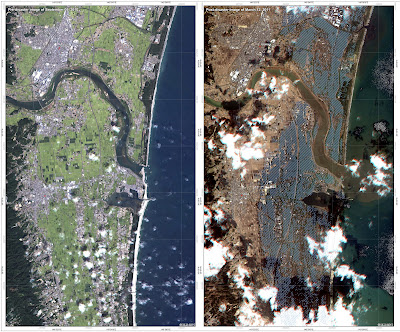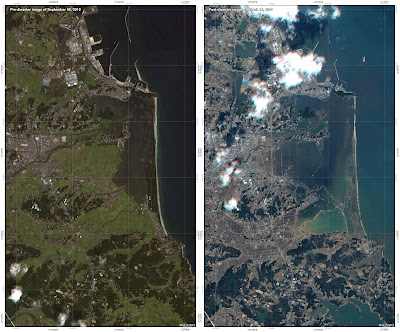In sorrowful images and video the world watches a landscape obliterated, the health and well being of Japan and its citizens in peril.

The images above were acquired by the German Optical RapidEye and radar TerraSAR-X satellites. They show Torinoumi on the eastern coast of Japan before the disaster on 5 September 2010 and after the tsunami on 12 March 2011. The German Aerospace Center, DLR, is responding to the disaster through its Center for Satellite Based Crisis Information, ZKI, to provide information for the International Charter. Credits: RapidEye AG, DLR, Google Earth. Map produced by ZKI

The map above shows a comparison of RapidEye pre-disaster data acquired on 5 September 2010 and post-disaster data acquired on 12 March 2011. The images focus on the city of Soma and the surrounding region, which was badly affected by the tsunami. Credits: RapidEye AG, DLR, Google Earth. Map produced by ZKI
One thought that resonated for me as I am bombarded with this imagery of an altered landscape are films I watched years ago as a teenager.
The atom bomb was dropped on Hiroshima and Nagasaki by the United States in 1945. As Japan rebuilt itself afterwards as a nation it carried the scars of the past war. Japanese filmmaker Ishiro Honda and Toho embodied the nation’s psyche and culture within the Godzilla (monster/sci-fi) genre of films. The original Gojira, (Godzilla) was a very serious, dark film created in 1952. (The re-edited Americanized version in 1954 still held a cautionary tale, but others that followed seemed to lose the original message.) This film spoke to the potential casualties of playing with nuclear fission, the havoc that could be wrought, an allegory for the anxiety held by a country and a foreboding message to future generations. The film ends with a thoughtful massage and prayer. So, again.

